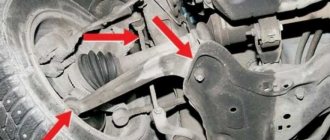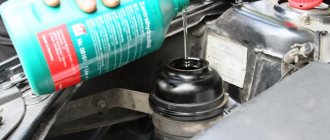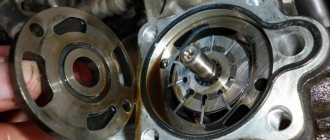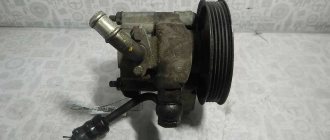How to understand that there is little fluid in the power steering system?
When a power steering leak occurs, fluid loss from the system always follows the same scenario in several stages.
Stage one.
If the power steering reservoir lacks only a little fluid to the normal level, then when the steering wheel is rotated, a sound similar to a howling or itching will begin to be heard from under the hood. But this sound will only be heard when the car is cold. The steering wheel should not become tight. As the car warms up, the sound will subside.
Stage two.
The howling or hum that appears will not subside even when the car warms up, and the steering wheel will become a little wobbly and tight. The sounds will only be heard when the steering wheel is turned.
Stage three.
The howl or hum from under the hood is no longer heard, and the steering wheel has become tight. This means that all the oil has already leaked out of the power steering system. To make sure of this, you need to open the tank lid and look inside.
Attention! Driving, even for a short distance (5 km or more) without any fluid in the power steering system, will most likely result in a damaged power steering pump.
The power steering pump cannot run dry. In most cases, after this it gets damaged - the rotor pair is scuffed, and cannot be repaired. Purchasing a new pump can cost from 10 to 18 or more thousand rubles. It is especially a pity for the power steering pump if it is a dual-circuit pump and is installed on a car with hydraulic suspension. Such a pump can cost from 30 to 100,000 rubles.
In this situation, it is advisable to call a tow truck. Or pour fluid into the power steering reservoir and try to drive under your own power until it leaks out again. If this happens too soon, then a tow truck cannot be avoided.
In the first and second stages of loss of fluid from the power steering , you can still move under your own power. As long as a sound is heard from under the hood when the steering wheel is rotated, and the steering wheel is not completely “petrified,” there is still some amount of oil left in the system, and the pump should not be damaged.
If tow truck assistance is not available.
And the loss of fluid in the system has reached the third stage. At the same time, adding oil does not bring results. Then you need to try to turn off the power steering pump to save it. On many vehicles, the pump is driven by a separate belt. In this case, you need to cut off this belt with a knife. However, before doing this, make sure that other vital units are not driven by the same belt.
The vehicle can be driven with the power steering pump turned off.
But the steering wheel will be tight. You cannot accelerate faster than 45 km/h. You need to try to drive straight and not maneuver too much. You can drive this way no more than 500 km. This is an emergency mode for the steering rack. With further driving it will fail.
If the steering rack leaks heavily, and the power steering pump cannot be turned off by removing the belt.
To save the pump, you can loop its oil line. Those. Place the hose from the pump outlet into the power steering reservoir. The oil will circulate in a circle, bypassing the steering rack. You can drive like this, but this is an emergency mode for the steering rack and you must follow the rules described above.
If any malfunctions of the power steering system occur, you can call the Power Steering Service company and make an appointment for repairs!
8
1200 rub. for the photo report
We pay for photo reports on car repairs. Earnings from 10,000 rubles/month.
Write:
What to do if the power steering hums ? This question is periodically asked by most car owners whose cars have this system installed. What could be the causes and consequences of the breakdown? And is it worth paying attention to this at all?
reasons why the power steering hums . Extraneous sounds indicate an obvious malfunction in the control system. And the sooner you fix it, the more money you will save and will not put yourself at risk of getting into an emergency with a faulty steering system of your car.
Causes of hum
An unpleasant power steering hum can occur under various circumstances. Let's look at the most basic reasons why the power steering hums when turning:
- Low fluid level in the power steering system. You can check this visually by opening the hood and looking at the oil level in the power steering expansion tank. It should be between the MIN and MAX marks. If the level is below the minimum mark, then it is worth adding fluid. However, before doing this, you must definitely find the cause of the leak. Especially if a little time has passed since the last top-up. As a rule, leaks occur at clamps and at joints. Especially if the hoses are already old. Before topping up, be sure to eliminate the cause of the leak .
- The filled liquid does not match the one recommended by the manufacturer. This can cause not only a hum, but also more serious malfunctions. The power steering also due to the fact that, although the fluid meets the specification, it is not intended for operation in special temperature conditions (in significant frosts).
The entire technological process
To change the power steering fluid on a Renault Duster, you need to place the car on a level place and then open the hood. The next step is removing the expansion system. To do this, one bolt is unscrewed.
Now you need to place two plastic bottles under the car and disconnect the hoses of the power steering expansion system, and then lower them into the bottles. All contents are drained into any accessible place, and the power steering reservoir itself is thoroughly washed and dried. To completely expel fluid from the system. You need to turn the steering wheel in different directions. To complete the effect, the engine can be started, but not for a long time, so as not to damage the power steering pump.
Then everything is put back together, the power steering reservoir is mounted in place and new oil is filled to the maximum level. Rotate the steering wheel again on different sides, and then add a little more fluid. The last stage is to start the engine and rotate the wheel again. After this, we turn off the car, open the power steering reservoir, after which we fill the oil to the nominal value.
Power steering hums when cold
Troubleshooting power steering and steering rack
There are several reasons why the power steering hums when cold. The first is that air is leaking through the low pressure lines . To eliminate it, it is enough to put two clamps on the tube going from the reservoir to the power steering pump. In addition, it is worth replacing the ring located on the suction pipe of the pump itself. After installing the clamps, we recommend that you use an oil-resistant sealant to coat the clamps and joints.
You can also conditionally identify another reason, the probability of which is low. Sometimes there are cases when insufficient (poor quality) pumping of the power steering system . In this case, an air bubble remains at the bottom of the tank, which is removed using a syringe. Naturally. that its presence can cause the indicated hum.
Elimination methods may include replacing oil hoses and/or racks, replacing the power steering pump, installing additional clamps on all hoses in order to prevent air leaks into the system. You can also perform the following procedures:
- replacing the O-ring on the expansion tank supply spout;
- installing a new hose from the reservoir to the pump using oil-resistant sealant;
- perform the procedure for expelling air from the system (when performing the procedure, bubbles will appear on the surface of the liquid, which must be given time to burst) by turning the steering wheel with the engine not running;
Another repair option is to replace the O-ring in the power steering pressure suction hose (and, if necessary, the hose itself and both clamps). The fact is that over time it loses elasticity and becomes rigid, that is, it loses elasticity and tightness, and begins to let air through, which enters the system, causing knocking and foam in the tank. The way out is to replace this ring. Sometimes a problem can arise because it can be difficult to find a similar ring in a store. But if you find it, be sure to replace it and place it on the mount and lubricate it with oil-resistant sealant.
For some cars, a special power steering repair kit is available for sale. If problems arise with this unit, the first thing you need to do is buy a repair kit and change the rubber gaskets that are included in it. Moreover, it is advisable to buy original kits (especially important for expensive foreign cars).
Power steering pump bearing
It is also necessary to ensure that there is no dirt in the system fluid . If it is present even in small quantities, over time this will lead to wear on the parts of the power steering pump, which will cause it to begin to make unpleasant sounds and work worse, which will be expressed in increased effort when turning the steering wheel, as well as possible knocking. Therefore, when replacing the fluid, be sure to check for dirt deposits at the bottom of the expansion tank. If they exist, you need to get rid of them. Check the filter in the tank (if there is one). It should be relatively clean and intact, tightly adjacent to the walls of the tank. In some cases, it is better to replace the entire tank and filter rather than try to clean them. Also in this case, it is necessary to remove the rail, disassemble it, wash it from dirt, and also replace the rubber-plastic parts. To do this you need to use the mentioned repair kit.
An unpleasant sound may come from the outer bearing of the power steering pump . Its replacement is easy, without the need to completely disassemble the unit. However, sometimes it can be difficult to find a replacement for him.
There are special additives that are added to power steering fluid. They eliminate the hum of the pump, relieve effort on the steering wheel, increase the clarity of the power steering, reduce the level of vibration of the hydraulic pump, and protect system parts from wear when the oil level is low. However, motorists have different attitudes towards such additives. They really help some, but they only harm others and speed up the time for replacing the power steering pump or replacing it.
When choosing a liquid, pay attention to its temperature characteristics so that it works normally in severe frosts (if necessary). Since oil with high viscosity will create obstacles to the normal operation of the power steering system.
Power steering hums when hot
If the power steering hums when hot, then there may be several problems. Let's look at several typical situations and methods for solving them.
- If the steering wheel begins to vibrate while the engine is warming up, it is necessary to replace the pump or repair it using a repair kit.
- When a knocking sound appears on a warm engine at low speeds, and disappears at high speeds, this means that the power steering pump has become unusable. In this case, there may be two ways out - replacing the pump and pouring thicker fluid into the power steering system.
- If you pour counterfeit liquid into the system, this may cause it to lose its viscosity , and accordingly, the pump will not be able to create the necessary pressure in the system. The solution is to replace the oil with the original one, after flushing the system (pumping with fresh fluid).
- Steering rack malfunction . When heated, the fluid becomes less viscous and can leak through the seals if they are damaged.
Power steering buzzes in extreme positions
Do not turn the front wheels for long periods of time
It should be taken into account that when the wheels are turned all the way, the power steering pump operates at maximum load. Therefore, it may make additional sounds that are not a sign of a malfunction. Some automakers report this in their manuals. It is important to distinguish precisely the emergency noises associated with problems in the system.
However, if you are sure that the sounds that appear are the result of a malfunction in the system, then it is necessary to carry out diagnostics. The main reasons that the power steering hums in extreme positions are the same reasons listed above. That is, it is necessary to check the operation of the pump, the fluid level in the expansion tank, the tension of the power steering drive belt, and the cleanliness of the fluid. The situation described below may also occur.
Typically, at the top of the gearbox there is a valve box, which is designed to control hydraulic flows. When the wheel is turned to its extreme position, the flow is blocked by the bypass valve, and the liquid passes through a “small circle,” that is, the pump works on itself and does not cool. This is very harmful for it and is fraught with serious damage - for example, scoring on the cylinder or pump gates. In winter, when the oil is more viscous, this is especially true. Therefore, do not keep the wheels turned all the way for more than 5 seconds .
What to do if the car steering wheel does not rotate well?
Checking the fluid level in the tank
A cylindrical reservoir, clearly marked, is placed near or in the pump, in which the liquid level is checked. The location of the reservoir is almost the same in almost all cars.
The translucent plastic from which the tank can be made allows you to determine the level without special devices, by eye. In a metal or plastic tank, a special dipstick mounted in the lid is used to check the level.
- Sometimes checking the level is not possible without idling the engine;
- The probes or reservoirs are sometimes equipped with notches for a cooled or running engine;
- All other cars have minimum and maximum level marking lines;
- The main thing is to achieve acceptable level values.
Checking the dipstick level
When checking that the level is located, it is necessary to remove it from the tank for the first time, wipe it dry, and then, insert it all the way, remove it.
Checking the color of the liquid
If the liquid has an amber, pink tint, or is transparent, then it is normal. The presence of brown or black liquid indicates contamination. These may be particles of rubber left by connecting hoses, seals, or rings. The car needs to be taken to a mechanic who identifies the parts that need to be replaced at the same time as the fluid.
Sometimes gur fluid appears darker than normal fluid should look. In this case, examine the liquid stain obtained while wiping the dipstick. Matching colors indicate that the fluid does not need to be replaced.
Filling the power steering reservoir with fluid
- If the reservoir has marks, feel free to add fluid to the desired level. When checking the level with a dipstick, add liquid in small doses so as not to overfill the tank;
- Before adding fluid, you need to know for sure that it is intended for use by your car, since in order for the system to be properly fed, a fluid of a certain viscosity (density) is needed;
- It is not recommended to use gear oil as a fluid. There are different types of fluids, and if you choose it incorrectly, the steering may fail and the seals may break;
- You should pour liquid carefully, trying not to overfill the tank - stay within the permissible limit. When the engine is running, the fluid expands, which increases pressure while driving, which can cause problems and lead to costly repairs.
Screwing the reservoir cap
Different brands of cars have different ways of closing the lid. You need to install it or screw it in. Before closing the hood of your car, make sure that the lid fits snugly enough.
This is interesting: What is the difference between camber and toe
Power steering hums after replacement
Sometimes the power steering starts to hum after an oil change. Unpleasant sounds can be caused by the pump if the system has been filled with oil that is less thick than it was before. The fact is that between the inner surface of the stator ring and the rotor plates the output increases. Vibration of the plates also occurs due to the unevenness of the stator surface.
To prevent such a situation, we advise you to use the oil recommended by the manufacturer. This will protect your car from system breakdowns.
It is also possible that a hum may occur after replacing the high-pressure power steering hose. One of the reasons may be a poor-quality hose. Some service stations make the mistake of installing ordinary hydraulic hoses instead of special hoses designed for high pressure and operation in the power steering system. This can cause airing in the system and, accordingly, a hum. The remaining reasons are completely similar to the cases listed above (knock on cold, hot).
Tips for using power steering
In order for the hydraulic booster to work normally and not knock, you must follow a few simple rules:
- Monitor the oil level in the power steering system , top up and change it on time. In addition, check its condition. There is always a risk of purchasing a low-quality liquid, which becomes unusable after a short period of use (check its color and smell).
- Do not hold the wheels in the extreme position (more than 5 seconds) . This is harmful for the power steering pump, which operates without cooling.
- When parking the vehicle, always leave the front wheels level (straight) . This will take the load off the power steering system the next time you start the engine. This advice is especially relevant in cold weather, when the oil thickens.
- If problems occur with the power steering (humming, knocking, increased effort when turning the steering wheel), do not delay repairs . You will not only fix the breakdown at a lower cost, but also protect your car, you and your loved ones from possible emergency situations.
- Constantly monitor the condition of the steering rack . This is especially true for the condition of anthers and seals. This way you will not only extend its service life, but also save money on expensive repairs.
Chevrolet Niva Manual
Bleeding the power steering system is necessary when replacing fluid, as well as to remove air that has entered the hydraulic drive when repairing or replacing individual components of the system. To bleed the hydraulic system, open the power steering reservoir cap and add fluid to the lower mark on the reservoir cap indicator. We start the engine and at idle speed check the fluid level in the tank. When the liquid level drops, add it to the lower mark. We turn the steering wheel left and right several times until it stops, making sure that the fluid level in the tank is at the lower mark. Remove the protective rubber cap from the bleeder fitting.
The bleeder fitting is located on the steering gear cover. We put a transparent hose on the head of the fitting, lowering its free end into the vessel. Using the “8” key, unscrew the fitting 1-2 turns. When a continuous stream of liquid appears in the hose, tighten the fitting. We return the steered wheels to the straight-line position of the car and let the engine run for another two to three minutes. Normal operation of the hydraulic booster should not be accompanied by noise. Turn the steering wheel all the way left and right again and, if necessary, add fluid to the tank to the bottom mark. After warming up and stabilizing the temperature of the working fluid, its level should be at the upper level, and in a cold state not fall below the minimum level.
Why does my power steering howl?
Let's make it clear right away: in some situations the power steering howls when turning , even if it is working properly. This sound occurs when the wheels are turned all the way to the right or left. With this steering wheel position, the power pump operates at its maximum intensity. Hence the howl or hum. Any car repair begins with diagnostics, so as soon as you notice that the power steering is howling , crunching or humming, you should find out the source of the problem. There can be many reasons for extraneous sounds, and even an experienced technician is not always able to determine what exactly happened offhand. The most common problems that cause the power steering howl :
- the fluid level in the power steering system has decreased;
- oil that is not recommended by the manufacturer has been filled in;
- the quality of the liquid does not meet the standard;
- air has entered the system;
- The power steering pump howls;
- steering rack is faulty;
- The drive belt is loose.
why the power steering howls . Now let's figure out what to do if such a problem occurs with your car.
Checking oil quality
Qualitative assessment includes the color of the liquid and the presence of foreign particles. First you need to understand the colors of oil for power steering Renault Duster.
- Red. As you know, it is used for automatic transmissions and power steering. It can be either mineral or synthetic.
- Yellow. Used for power steering Renault Duster. Is the most common type of oil
- Green. It is used only in power steering and is not used for automatic transmissions.
Mixing different colors is not recommended, as the oil can have completely different compositions. In addition, color is necessary for a qualitative assessment, and for it to be correct, it is necessary to maintain the designated color of the oil.
Visual inspection can be used to assess fluid quality. If the fluid in Renault Duster is yellow, then it should remain the corresponding color. If it becomes darker, then contaminants have entered it, which negatively affects the operation of the system. Therefore, an urgent replacement is necessary.
Low level
It is easy to diagnose this malfunction - just check the power steering expansion tank, which is located in the engine compartment. The oil level should be between the MIN and MAX marks. If there is less fluid, add, but first eliminate the cause of the leak. Carefully check the clamps and joints - in 90% of cases, leaks occur in these places. As soon as you hear the power steering howling , add the Suprotec power steering tribotechnical compound to the fluid. The product will help to minimize the damage caused to the vehicle component as a result of abnormal operation. If the damage is minor, the functionality of the hydraulic booster will be fully restored.
Tribotechnical composition Suprotek "GUR" for power steering
To restore performance and extend the life of the power steering
Incorrect choice
If you mistakenly or in a hopeless situation filled in a liquid that is not on the list of brands recommended by the manufacturer, there is only one way out - urgently replace it. Operating the car in this case will lead to the fact that the power steering will not only howl , but will generally fail.
To neutralize the consequences of operating the hydraulic booster with unsuitable oil, after replacing the fluid, fill the system with the Suprotec “GUR” tribotechnical compound. This development of domestic engineers protects rubbing and friction parts from wear. The product restores minor damage and forms a layer that retains more lubricant on the surfaces of mechanical components.
Answers (3)
The power steering of the Chevrolet Niva is filled with Pentosin Hydraulic Fluid CHF11S VW52137. It is filled for the entire life of the car and does not need regular replacement.
In case of fluid replacement, in addition to the original one, you can use, for example, GM (article 19 40 715).
special for power steering. There are many of these, not necessarily the original one, since it is expensive and can still be difficult to find.
Instead of Pentosin, you can fill it with Mannol CHF - its analogue. You can also add Dexron IID while flushing the system.
Low-quality or expired liquid
The hydraulic booster is filled with oil, which is similar in characteristics to ATF for automatic transmissions. Just like in an automatic transmission, during operation the fluid “ages” and can no longer effectively lubricate the pump, seals and other parts. This is one of the reasons why the power steering howls .
If you hear unusual sounds in the steering column area, check the condition of the fluid. Take a little oil from the power steering expansion tank into a regular syringe and drop it onto a piece of paper. The color of the drop should be red, green or blue (depending on the brand). If the fluid has turned dark brown, gray or black, it needs to be replaced urgently.
A burning smell is also a signal for immediate replacement. The schedule for changing the power steering oil depends on the car model. The timing is indicated by the manufacturer in the technical documentation for the machine. As a rule, the interval is about 100 thousand kilometers, but at least once every two years. If you have been driving for some time with a power steering howling due to poor oil quality, after replacing the fluid, add the tribotechnical composition “Power Steering” from Suprotec to it. Approximately 30 milliliters of product should be added per liter of oil. Strictly follow the instructions for use.











